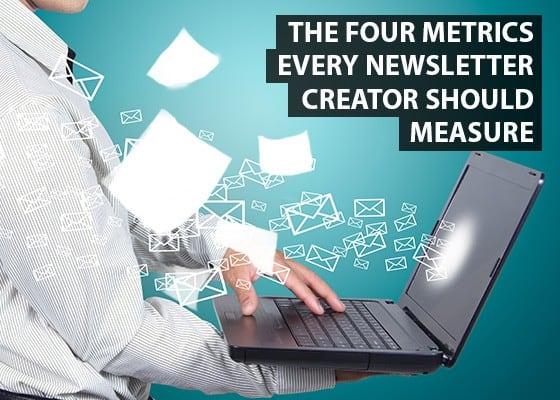Can you calculate the ROI on newsletters as part of your email marketing strategy? Yes, with these four metrics, you really can.

The email newsletter is often regarded as the poor sibling to a ‘proper’ sales email – the kind you send to prospects to see if they’re interested in a dialogue – because the motivation behind each is perceived to be different. Traditionally, a newsletter is for achieving softer marketing goals, such as generating brand impressions, communicating with customers and creating a ‘relationship’ to influence purchasing decisions. A sales email is traditionally used to achieve harder revenue-producing goals, such as generating new leads, inquiries, and direct sales.
‘Promotions focus on persuasion, newsletters on trust and loyalty. Promotions look for immediate returns, newsletters for long-term benefits. Promotions make an offer, newsletters offer value.’Mark Brownlow, founder of Email Marketing Reports
However, ultimately all B2B and B2C emails and newsletters are intended to sell – some are just more blatant in their goal than others. Which is why metrics for newsletters are just as important as for a promotional mail.
The usual metrics are important to measure, such as delivery, open and click-through rates.
Newsletter subscribers tend to be long-term, loyal customers, so you should look at the days and weeks following each newsletter. Are subscribers making newsletter-inspired purchases? Have they logged into their accounts? Is there an upswing in wish-list additions? While a 2% click-through rate for an online ad campaign is typically considered a success, email newsletters can consistently get 15% to 25% click-through rates.
However, to measure the true impact of newsletters – and to identify opportunities for improvement – it’s necessary to look beyond these metrics. Here are four assessments you should be making, against your objectives, of your newsletter marketing strategy.
1. Responder segmentation analysis
What did you want your newsletter to achieve? Use your database search tools to profile which of the people on your mailing list actually clicked on one of the calls to action in your newsletter. Do this on a campaign-by-campaign basis, and in aggregate for all campaigns conducted quarterly/semi-annually/annually to reveal valuable trends. For instance, you might find that analysis by age indicates that your subscribers aged 35-45 are more responsive than 25-35 year-olds, or analysis by geography might indicate that your subscribers in Europe are more responsive than subscribers in the US. This information would change your choice of content, how you position your offers, and affect your creative decisions for copy, fonts, images etc. It would help you to improve targeting and segmentation of future newsletters. It would also enable you to adapt newsletters to improve response on less-active segments.
2. Newsletter subscriber engagement analysis
A responder segmentation analysis tries to paint a picture of who responders are. However, a newsletter subscriber engagement analysis is concerned with measuring the total reach and effectiveness of newsletter marketing to your list.
Use your database tools to analyse cumulative actions by responder during defined time periods (e.g. quarterly or annually). Analysing the frequency distribution of clicks, queries and actual sales across your list over time will tell you a lot about the depth and breadth of your newsletters’ impact. It will enable you to uncover both the most active responders and also inactive list segments. You can use this data in various ways, such as: offering best responders ‘rewards’; enticing infrequent responders with ‘incentives’ to see if this improves engagement; and either seeking to rejuvenate or deciding to dismiss weak or non-responsive segments.
3. Channel contribution analysis
This analysis tries to determine the bottom-line economic impact of newsletters on your business, whether by direct sales revenue or other measures such as: leads generated, social media connections made, increased site traffic etc.
4. Subscribe/unsubscribe ratio
People naturally unsubscribe from newsletters as their interests change, but your business needs to ensure that they are replaced. Where unsubscribers outnumber new subscribers, you need to investigate what the cause could be. Critically, have people lost interest? Or is your newsletter content irrelevant?
Soliciting feedback from unsubscribers will instantly tell you what they do and do not like. Then you can adjust your email marketing strategy so that future newsletters have a lower unsubscribe rate. Give the customer what they want and they should keep coming back for more.
‘If you handle it right, the dialogue between you and your customers can become the lifeline of your business. To establish and maintain a healthy flow, customer feedback must result in change your customers can see. Change is the most powerful currency to reward vocal and consultative customers.’Whitney Wood, managing partner of the Phelon Group
Don’t forget:
- Email newsletters can be up to 50 times more effective for click-throughs than a standard marketing email.
- Newsletters do have an ROI, but the calculation is slightly different to that of an email with a single offer included.
- Less isn’t necessarily more. Recipients expect up-to-date, up-to-the-minute news and articles. The quicker you can get your article to them, the better chance you have of getting a response.
- Keeping subscribers on-board is more valuable than trying to attract new ones.
- Don’t be afraid to ask for feedback if things appear to be going badly.
- It doesn’t matter what sort of email you are sending, collecting and analysing metrics to identify trends will help you improve ROI and revenue.

